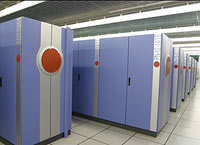|
|
|||||||
|
|
|||||||
|
|||||||
| | Web Japan >> | Trends in Japan >> | Science & Technology >> | Super Competition | |
|
SUPER COMPETITION Japan Launches Effort to Build World's Fastest Supercomputer (November 22, 2005)
The World of Teraflops Since the latter half of the 1970s, Japan and the United States have competed fiercely to develop the fastest supercomputer. In 2002, Japan took the lead with the Earth Simulator, maintained by the Japan Marine Science and Technology Center (now the Japan Agency for Marine-Earth Science and Technology). This computer has a peak speed of 36 teraflops (one teraflop means one trillion floating-point operations per second), which when the Earth Simulator was built was more than five times as fast as the nearest competitor, making it by far the world's top-performing computer. Japan maintained its lead for two years, but in autumn 2004 the Earth Simulator was unseated by the Lawrence Livermore National Laboratory's Blue Gene/L, built by IBM. Supercomputers constructed by US companies also occupied second and third positions in the 2005 ranking, pushing the Earth Simulator down to fourth place. Unsatisfied with this position, the Japanese government announced that it will begin development in fiscal 2006 (April 2006 to March 2005) of a 10-petaflop high-performance, multi-purpose supercomputer (one petaflop means 1,000 trillion floating-point operations per second). This computer will be some 250 times faster than the Earth Simulator, making it a "dream machine" capable of processing 10 quadrillion operations per second. Toward a Human-Body Simulator There are three basic types of supercomputers: vectors, which compile and compute vast amounts of data; accelerators, which are extremely high performing in specific fields; and scalars, which are adept at minutely breaking down and processing data. Japan's new supercomputer will be a multi-purpose machine functioning as a composite of all three types. In the life-science fields, where computer simulation is currently limited to the molecular level, the development of this multi-functional supercomputer will enable an entire human body - from genes to the body's cells and blood flow - to be simulated in just half a day. The computer is also expected to be used for predicting natural disasters, the design of everything from raw materials to finished products in the nanotechnology field, and providing insight into the formation of galaxies. MEXT plans to establish the Advanced Computing Science and Technology Center (provisional name) to develop and maintain this next-generation supercomputer. It will be the world's leading center for supercomputer research and education and will also serve to nurture world-class researchers. Copyright (c) 2005 Web Japan. Edited by Japan Echo Inc. based on domestic Japanese news sources. Articles presented here are offered for reference purposes and do not necessarily represent the policy or views of the Japanese Government. |
||||||||
|
||||||||



